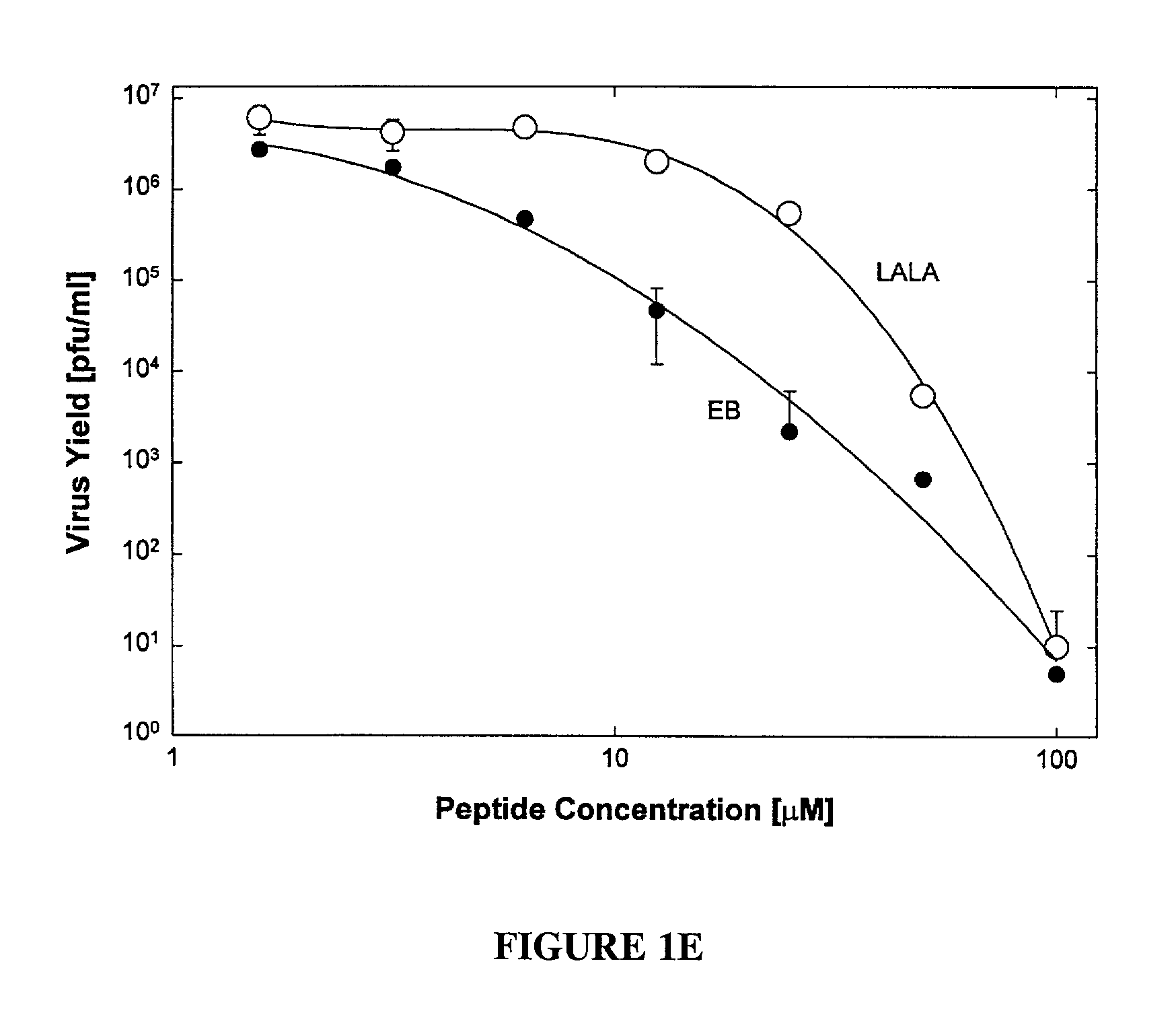Pharmacologically active antiviral peptides and methods of their use
a technology of antiviral peptides and pharmaceutically active peptides, which is applied in the field of pharmaceutically active antiviral peptides, can solve the problems of not being bioavailable, not being functional, and not being effective in preventing initial viral infection with synthetic peptides
- Summary
- Abstract
- Description
- Claims
- Application Information
AI Technical Summary
Benefits of technology
Problems solved by technology
Method used
Image
Examples
example 1
Protocols and Materials
[0042] Cell culture and virus: The procedures for growing Vero cells and preparing high titer stocks of HSV-1 KOS as described in (Grau et al., Invest. Ophthal. and Vis. Sci. 30: 2474 (1989)) were utilized. Vero cells were maintained in carbonate-buffered DMEM supplemented with 5% calf serum and 5% fetal bovine serum (regular medium). For some studies, cells were switched to serum-free DMEM buffered with 25 mM Hepes (pH 7.4) and allowed to adapt to that medium for 30 min prior to experimental treatments. Vero cells were seeded into wells (0.28 cm2) of microtiter plates either at 3.5×104 cells / well for use 1 day later (8×104 cells / well) or at 1×104 cells / well for use 3 days later (2×105 cells / well).
[0043] Plague reduction assay: Confluent Vero cell cultures in microtiter plates were infected for 1 hour at 37° C. in 40 μl of medium. Except where indicated, peptide treatments in 40 μl of medium lasted from 1 hour before through 1 hour after infection. At the en...
example 2
Antiviral Activity of Antiviral Peptides
[0051] The antiviral peptide EB (SEQ ID NO:1), was an effective antiviral agent when present during infection of Vero cell cultures with HSV-1 KOS, blocking plaque formation as shown in FIG. 1A (●), FIG. 1B (●) and FIG. 1D (◯); and reducing virus yields by up to eight orders of magnitude depending on concentration (see FIG. 1E). Compared to a control peptide FIG. 1A (◯) and FIG. 1B (◯) EBX, the antiviral peptide EB was a far more effective antiviral, blocking infections at 10 or 100-fold lower concentrations depending on the presence (FIG. 1A) or absence (FIG. 1B) of serum.
[0052] The cytotoxic effects of antiviral peptide EB, as measured by trypan-blue exclusion in the absence of serum, were seen only at concentrations 100-fold higher (FIG. 1C, (●); IC50=68 μM) than antiviral concentrations (FIG. 1B, (●); IC50=0.7 μM). In the presence of serum, cytotoxic effects were seen first at 200 μEB (FIG. 1C, (Δ)). No cytotoxic effects were associated ...
example 3
Comparison of Antiviral Activity of Antiviral Peptide vs. Acyclovir
[0058] Vero cell cultures as prepared in Example 1 were infected with HSV-1 and assayed for virus production as described in Example 1. The antiviral activity of an antiviral peptide according to the present invention EB (SEQ ID NO:1) was compared to the antiviral activity of the current HSV antiviral nucleoside standard, acyclovir. The two peptides were added to the Vero cells one hour prior to infection with HSV. As FIG. 3 illustrates, although acyclovir shows the highest antiviral activity at low dosages, at high concentrations, i.e., those exceeding 10 μM of the active ingredient, EB showed the greatest antiviral activity.
PUM
| Property | Measurement | Unit |
|---|---|---|
| solubility | aaaaa | aaaaa |
| hydrophobic | aaaaa | aaaaa |
| Solubility | aaaaa | aaaaa |
Abstract
Description
Claims
Application Information
 Login to View More
Login to View More - R&D
- Intellectual Property
- Life Sciences
- Materials
- Tech Scout
- Unparalleled Data Quality
- Higher Quality Content
- 60% Fewer Hallucinations
Browse by: Latest US Patents, China's latest patents, Technical Efficacy Thesaurus, Application Domain, Technology Topic, Popular Technical Reports.
© 2025 PatSnap. All rights reserved.Legal|Privacy policy|Modern Slavery Act Transparency Statement|Sitemap|About US| Contact US: help@patsnap.com



